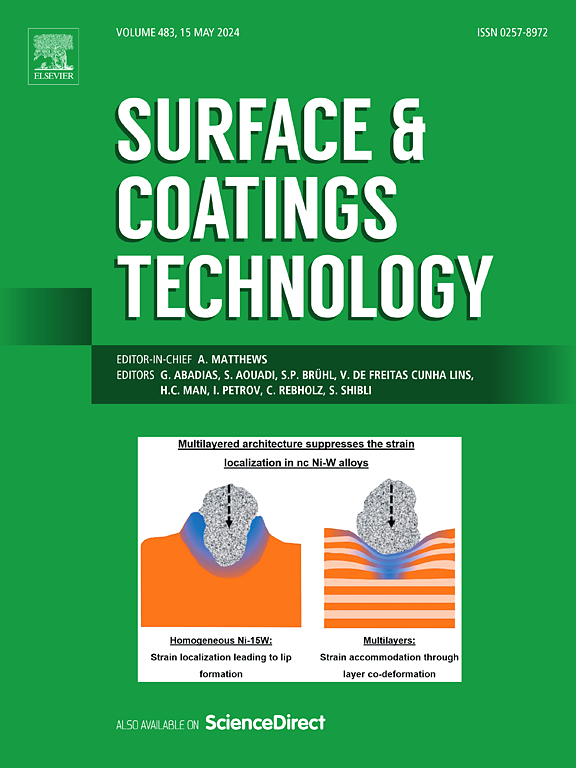Impact of surface laser treatment on the high-frequent cyclic ablation of vermicular graphite cast iron
IF 5.3
2区 材料科学
Q1 MATERIALS SCIENCE, COATINGS & FILMS
引用次数: 0
Abstract
The cylinder head of a high-power diesel engine is often subjected to a harsh cyclic ablative environment. Vermicular graphite cast iron exhibits commendable mechanical properties and high-temperature performance. However, the occurrence of thermal cracking can lead to a deterioration in cyclic ablative resistance. Surface laser treatment can enhance the thermal stability of the material, which exists potential to mitigate such failures. To investigate the impact of surface laser treatment on the high-frequent cyclic ablation of vermicular graphite cast iron, we prepared surface-modified vermicular graphite cast iron by applying varying laser power to its surface. The results indicated that different microstructures were observed on the laser-treated surface of vermicular graphite cast iron. Vermicular cast iron subjected to laser treatment at power levels of 300 W and 500 W demonstrates an increase in hardness, which can be attributed to the formation of fine ledeburite and martensite on its surface. The 500 W treated vermicular graphite cast iron showed the best ablation resistance. The mass and line ablation rates are −0.026 mg/s and −0.12 μm/s, respectively. The damage to the matrix is less significant compared to that of other materials. The reason lies in its small and uniform surface structure, which can mitigate thermal stress damage during the initial stages of ablation and enhance its oxidation resistance. By reducing the thickness of the oxide layer, the thermal conductivity of the surface is improved, resulting in a decrease in surface temperature and an enhancement in the material's resistance to high-frequent cyclic ablation.
表面激光处理对蠕墨铸铁高频循环烧蚀的影响
大功率柴油机的气缸盖经常处于恶劣的循环烧蚀环境中。蠕墨铸铁具有良好的机械性能和高温性能。然而,热裂的发生会导致循环烧蚀性能的恶化。表面激光处理可以提高材料的热稳定性,这有可能减轻此类故障。为了研究表面激光处理对蠕墨铸铁高频循环烧蚀的影响,我们在蠕墨铸铁表面施加不同的激光功率制备了表面改性的蠕墨铸铁。结果表明,激光处理后的蠕墨铸铁表面出现了不同的显微组织。在功率为300 W和500 W的激光处理下,蠕墨铸铁的硬度有所提高,这是由于其表面形成了细小的莱氏体和马氏体。500w处理的蠕墨铸铁的抗烧蚀性能最好。质量烧蚀率为- 0.026 mg/s,线烧蚀率为- 0.12 μm/s。与其他材料相比,对基体的损伤较小。其原因在于其表面结构小而均匀,可以减轻烧蚀初期的热应力损伤,增强其抗氧化性。通过减少氧化层的厚度,提高了表面的导热性,从而降低了表面温度,增强了材料对高频循环烧蚀的抵抗力。
本文章由计算机程序翻译,如有差异,请以英文原文为准。
求助全文
约1分钟内获得全文
求助全文
来源期刊

Surface & Coatings Technology
工程技术-材料科学:膜
CiteScore
10.00
自引率
11.10%
发文量
921
审稿时长
19 days
期刊介绍:
Surface and Coatings Technology is an international archival journal publishing scientific papers on significant developments in surface and interface engineering to modify and improve the surface properties of materials for protection in demanding contact conditions or aggressive environments, or for enhanced functional performance. Contributions range from original scientific articles concerned with fundamental and applied aspects of research or direct applications of metallic, inorganic, organic and composite coatings, to invited reviews of current technology in specific areas. Papers submitted to this journal are expected to be in line with the following aspects in processes, and properties/performance:
A. Processes: Physical and chemical vapour deposition techniques, thermal and plasma spraying, surface modification by directed energy techniques such as ion, electron and laser beams, thermo-chemical treatment, wet chemical and electrochemical processes such as plating, sol-gel coating, anodization, plasma electrolytic oxidation, etc., but excluding painting.
B. Properties/performance: friction performance, wear resistance (e.g., abrasion, erosion, fretting, etc), corrosion and oxidation resistance, thermal protection, diffusion resistance, hydrophilicity/hydrophobicity, and properties relevant to smart materials behaviour and enhanced multifunctional performance for environmental, energy and medical applications, but excluding device aspects.
 求助内容:
求助内容: 应助结果提醒方式:
应助结果提醒方式:


